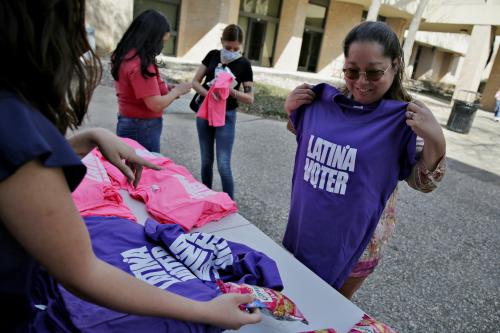The Latino electorate was once again pivotal to election outcomes across the nation, including key Senate races in Nevada, Arizona, and Colorado. The 2022 Midterm Voter Election Poll, conducted by the African American Research Collaborative (AARC), has a large sample of Latino voters with enough samples from key states (n-400 per state) to explore important differences across the diverse Latino electorate.
Latino voters remained solidly Democratic in their voting preferences in 2022, with 64% of Latinos reporting that they voted for a Democratic House candidate, compared to 33% who reported they voted for Republican candidates. The final 3% voted for a candidate from another party. As reflected in the figure below, there was a similar distribution among Latino voters across Senate races.
Latinos’ support for Democratic House candidates decreased by 5% from 2020, but the movement toward the GOP was not as pronounced as pre-election surveys suggested it might be this cycle. This analysis points to a small but consistent shift among Latinos toward the Republican Party across most sub-groups of the overall Latino electorate. This modest shift was nowhere near large enough to help the “red wave” materialize in 2022 and is consistent with historic shifts in vote choice away from the president’s party in off-year elections during their first term in office.
The Role of Latinas in the 2022 Midterms
My pre-election analysis suggested that Latinas were a key sub-group of the Latino electorate whose movement toward the Republican Party was noticeable over time. Latinas defied pre-election surveys and once again voted for Democratic candidates at a high level, with 68% of Latinas casting ballots for Democratic House candidates, higher than the 58% for Latino men. The 10% gender gap among Latinos in 2022 mirrors the gap in the 2016 election.
Latinas were twice as likely to indicate that the most important issue driving their voting decision this cycle was women’s reproductive health and abortion relative to Latino men, with 16% of Latinas across the country noting that this was the most important issue that candidate pick for their congressional district. Conversely, Latino men were twice as likely to indicate that they “always vote Republican” in congressional races relative to Latinas (17% for Latino men and 9% for Latinas). The survey numbers suggest that the Democrats’ focus on access to abortion helped stall the movement toward the GOP among Latinas.
Latinos Partisan Preferences by Age, Origin, and Religion
Latinos’ voting differences across age groups also show stark differences and important trends. Latinos under the age of 40 were more likely to vote for a Democratic candidate in 2022 (67%) compared to 60% among Latinos over 40. This is almost identical to the Democratic voting percentages for Latinos under 40 years of age in 2020. However, there was a noticeable decrease in the Democratic vote share among Latinos over the age of 60, 74% of whom voted for a Democratic House candidate in 2020 compared to 61% in 2022. Biden’s approval rating of 59% among Latinos 60 years of age or older was lower than Latinos of younger ages, and Latinos 60 or older were the most likely to identify “inflation and cost of living” as the most important issue that drove their congressional vote at 21%.
Latino House Vote by Demographic Profile
 Source: 2022 AARC Midterm Voter Election Poll
Source: 2022 AARC Midterm Voter Election Poll
Democrats did not do as well in the battle for Independent voters in 2022, with 53% of self-identified Latino Independents voting for a Democratic candidate in 2022 compared to 60% in 2020. Gas prices were particularly salient to Latino Independents, as they were twice as likely as Latino Democrats or Republicans to identify gas prices as the most important issue that drove their congressional voting decision. Democrats also lost some ground among partisans, with 94% of self-identified Democrats voting for a candidate from their party in 2022 compared to 96% in 2020. Similarly, 7% of self-identified Republicans voted for a Democratic candidate in 2022 compared to 10% in 2020.
Although there were no major national-origin groups among Latinos that had higher Republican support than Democratic, there were razor thin margins for Cuban American and South American Latinos who supported Republicans at rates of 46% and 47%, respectively. Cuban Americans were one of the few sub-groups of Latino voters who shifted toward the Democrats in 2022—55% Republican in 2020. However, South Americans increased their Republican percentage by a large margin, +18% from 2020.
In an election season where abortion policy was a major theme, we wanted to explore variation based on religiosity. Given media narratives about Latinos being more religious and thus socially conservative on issues such as abortion, 2022 was an important election to examine those claims. Support for Republican candidates increased with the importance of religion in Latinos’ daily lives; only 24% of Latinos who indicated that religion was not important to their daily lives voted for a Republican House candidate, compared to 33% for those for whom religion is somewhat important, and 37% for Latinos whose religion is very important to their daily lives.
Latino Voting Preferences by State
Democratic support among Latinos in the critical states of Michigan (74%), Pennsylvania (73%) and Colorado (71%) proved vital in Senate and governors races. Florida was the lone state where the majority of Latino voters supported Republican House candidates (54%), and the Latino vote mirrored the overall electorate in the state of Florida which was one of the few states where Republicans performed up to pre-election expectations.
 Source: 2022 AARC Midterm Voter Election Poll
Source: 2022 AARC Midterm Voter Election Poll
The electoral consequences of the shift in Latino voting behavior from 2020 is most apparent when we look at state-level variation. Georgia had the most dramatic shift across key states this cycle with a 13% decrease in the Latino Democratic vote relative to 2020, and Pennsylvania also saw a significant decrease of 9%. Although votes are still being counted in Georgia, it does not appear as though this Latino movement in 2022 cost Democrats valuable Senate seats.
 Source: 2022 AARC Midterm Voter Election Poll; 2020 American Election Eve Poll
Source: 2022 AARC Midterm Voter Election Poll; 2020 American Election Eve Poll
Similarly, although Latinos in Colorado were more balanced in their voting behavior in 2022, the solid 71% Democratic support among Latinos in Colorado helped make this a big night for Democrats in the state. Fresh survey data from Colorado reveals that Latino voters overwhelmingly supported Democratic Latina candidate Yadira Caraveo at 75%, with higher Democratic vote support in this district than the state overall.
Latinos comprised one fifth of Nevada’s electorate this fall, making the Latino vote critical to the surprisingly tight Senate race in the state featuring incumbent Cortez-Masto, the first Latina elected to the U.S. Senate. Nevada was a state where Democrats saw a slight but important gain in Latino support which may prove to be consequential in a too-close-to-call Senate race. Latinos supported Cortez-Masto over Republican nominee Adam Laxalt at 63% and 35%, respectively, a margin which may prove to be enough to help the Latina senator keep her seat, if Latino turnout is sufficiently high.
The Economy and Abortion Drove Voting Decisions for Latinos in House Races
Latinos have faced tremendous financial challenges over the past year, including disproportionately high unemployment rates that at one point were nearly three times as high as the national average. It is, therefore, not surprising that when asked to identify the most important policy issues that drove their congressional voting decision in 2022, “inflation/cost of living” was the leading issue for Latinos at 18%. When you add the “price of gas” at 5% and the “cost of healthcare” also at 5%, it was clear that the economy was the dominant theme for Latino voters in 2022.
The fact that jobs and the economy was second only to the COVID pandemic among Latino voters in 2020 speaks to just how difficult the last two years have been on the economic wellbeing of the Latino community. The party who can gain Latinos’ trust in improving their personal economic standing will stand to do well with Latino voters in 2024.
One of the dominant themes in this year’s race following the Dobbs decision was abortion policy. This led 9% of Latinos to identify “women’s reproductive and abortion rights” as the most important issue that impacted their House vote, second only to inflation/cost of living across all policy issues.
President Biden and major Democratic surrogates’ (including former President Obama) closing message to voters focusing on the protection of democracy, did not gain high traction with Latino voters. Only 1% of Latino voters identified “election reform and protecting voting rights” as the policy that drove their voting decision.
The Latino Policy Agenda and Looking Ahead to 2024
In sum, the policy priorities of the Latino electorate gives both parties a clear idea of the Latino policy agenda at this point in time. When asked to identify the most important issues that they want Congress and the president to address moving forward, Latino voters want to see action taken on the rising cost of living and inflation, including a particular focus on lowering the cost of gas. Protecting women’s reproductive health care rights is the next most commonly identified policy priority among Latinos. Latinos also want to see policy action to address gun violence and mass shootings (23%) and the cost of health care (22%). Rounding out the top policies on the Latino agenda is climate change/extreme weather (16%).
As we concluded the campaign season, our attention immediately turned to the implications of the 2022 midterm election on the presidential race that will come in two years. When asked if they would be worried if “Donald Trump becomes President again he will promote hate and division and our country will fall apart” a majority of 59% of Latino voters are worried, 43% are very worried. If Trump does represent the GOP in 2024, it is likely that this high concern among Latinos will generate even higher turnout and Democratic support than what we observed in 2022.
The survey data referenced herein was produced independently by a third-party firm, BSP Research on behalf of the African American Research Collaborative. Outside of his work at Brookings, Dr. Gabriel Sanchez serves as Director of Research for BSP Research and was part of the group of scholars who designed and implemented this survey.
The Brookings Institution is committed to quality, independence, and impact.
We are supported by a diverse array of funders. In line with our values and policies, each Brookings publication represents the sole views of its author(s).








Commentary
Latinos support Democrats over Republicans 2-1 in House and Senate elections
November 11, 2022